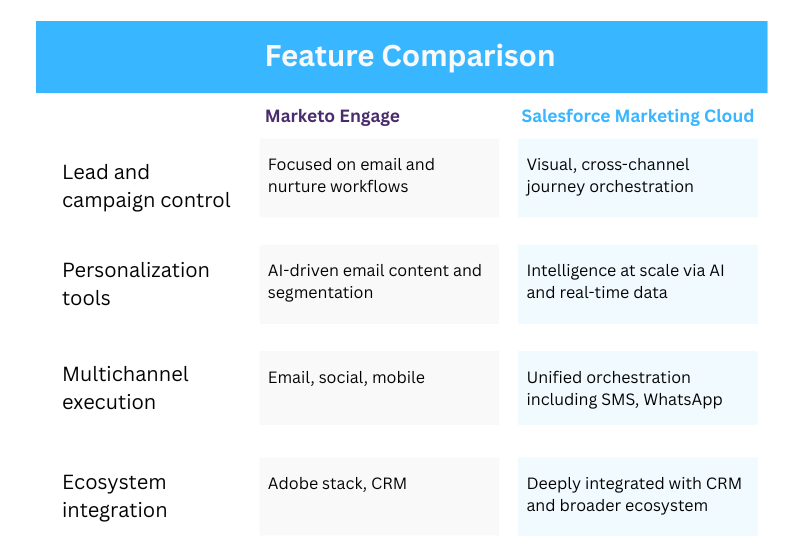Choosing a marketing automation platform is like choosing the command center for your growth engine. Between Marketo vs Salesforce, savvy organizations face an important foundational decision. Marketo brings a legacy of strong lead nurturing and B2B focus. Salesforce builds on its CRM roots to offer a broader customer experience solution.
The global market for marketing automation is projected at around $6.9 billion this year and is expected to nearly triple by 2032. There is high demand for efficiency and personalization-driven campaigns. Salesforce’s Marketing Cloud (especially its Account Engagement arm) has earned recognition as a leader in the 2024 Gartner Magic Quadrant for B2B marketing automation platforms for the seventh consecutive year.
This blog will help you fully understand the Salesforce vs. Marketo comparison so you can make the right choice for your business.
Overview of Marketo and Salesforce
Marketo began in 2006 as a tool for B2B marketers who needed a better way to manage leads and automate outreach. It built its reputation on strong lead nurturing capabilities and flexibility in campaign design. Adobe acquired the platform in 2018, integrating it into the Adobe Experience Cloud. This gave Marketo deeper creative and content management capabilities, which appeal to marketing teams that already rely on Adobe products.
Salesforce took a different path. Originally built as a CRM in 1999, it expanded over the years to cover every stage of the customer journey. Its marketing automation capabilities come through Salesforce Marketing Cloud and Account Engagement (formerly Pardot). The strength of Salesforce lies in its ability to unify sales, service, and marketing functions under one system, powered by real-time customer data and advanced analytics.
At a glance, both platforms can help organizations execute multi-channel campaigns, manage customer data, and measure results. The key difference is scope. Marketo focuses primarily on marketing functions, while Salesforce offers an end-to-end environment that connects marketing automation directly to sales, service, and commerce to make it easier to align every part of the business toward a consistent customer experience.
Key Features and Capabilities
Both platforms bring robust tools to the table. Here's an overview of what to expect from each platform.

Marketo Engage
Marketo stands out in the following areas:
- Lead management: Strong lead scoring, progressive profiling, and lead nurturing workflows support targeted campaigns and conversion tracking.
- Advanced email marketing: You’ll find dynamic content, A/B testing, behavioral triggers, and personalization powered by AI—Marketo taps into Adobe Sensei GenAI to optimize email and content recommendations.
- Omnichannel reach: Marketo enables engagement across email, social media, mobile, and offline touchpoints, helping a cohesive customer journey.
- Campaign operations and analytics: The platform includes a campaign builder, engagement map visualizations, and predictive analytics dashboards for insight-driven strategy adjustments.
Salesforce Marketing Cloud
Salesforce brings a wider toolbox, built for scale and cohesion:
- Journey Builder: Design and automate customer workflows across email, SMS, and social. Analytics flow in real time, helping your team act at the right moment.
- Data management and segmentation: Data Extensions unify customer data from all sources. Audience Builder segments audiences from that unified view, simplifying personalization.
- AI-driven personalization and intelligence: Predictive Intelligence delivers smart recommendations, optimizes send times, and helps mitigate churn. Salesforce also consistently lands in the leader quadrant for multichannel marketing hubs.
- New AI tools: In 2024 Salesforce introduced Agentforce—its generative AI agent system. Marketers now can produce emails and landing pages via campaign prompts, with growing support for channels like WhatsApp in flows.
Related Article: Salesforce Marketing Cloud Implementation in 2025

Integration and Data Management
Organizations that anchor their systems in CRM benefit from streamlined workflows and tighter alignment. Here’s how each platform handles integration and data:
- Marketo Engage connects reliably with Salesforce CRM and other CRM systems for two-way lead syncing and campaign tracking. It supports foundational lead management workflows and account-based marketing efforts.
- Salesforce Marketing Cloud takes a broader approach:
- Its Data Cloud captures both structured and unstructured customer data, enabling real-time personalization and a unified customer profile across channels.
- Einstein Marketing Intelligence automates data preparation and campaign analytics, delivering performance insights in real time.
Related Article: Cloud Integration Solutions with MuleSoft & Agentforce
You also gain seamless campaign orchestration across email, mobile, social, and web to support cross-channel marketing and provide visibility across the entire customer journey
Usability and Learning Curve
Ease of adoption matters, especially when rolling a system out across teams. Here’s how the platforms compare:
- Marketo Engage tends to feel more approachable for marketing operations teams. Its interface and workflows generally get users ramped up quicker with less dependence on specialized developers or long training cycles.
- Salesforce Marketing Cloud, while powerful, can be more complex to master. Most teams encounter a steeper learning curve, particularly around journey building, Data Cloud, and AI functionality. But that investment pays off by enabling simplified cross-functional collaboration and broader automation.
Key usability factors:
- Training and community support
- Marketo’s Marketing Nation provides strong peer support for marketing teams.
- Salesforce offers wide-ranging resources—from Trailhead modules to a global partner ecosystem—which help offset the initial complexity once your team invests in learning.
- Interface and interface design
- Marketo offers familiar campaign flows and dashboard views that feel intuitive.
- Salesforce presents a richer environment, including drag and drop Journey Builder, AI tools like Agentforce, and Slack-powered collaboration—all of which can feel like a toolkit, not just a platform.
In short, Marketo may be easier to launch, but Salesforce’s breadth and integration capabilities offer more long-term payoff for teams ready to scale.
Pricing Models and ROI Potential
Pricing often plays a big role in the Marketo vs Salesforce decision. Both platforms follow a subscription model, but the way costs scale is different.
- Marketo Engage pricing is based on database size and feature tiers. As your number of leads grows, so does your cost. For organizations that don’t need every advanced capability, Marketo can appear more affordable at first—but adding features or integrations often pushes the price up quickly.
- Salesforce Marketing Cloud offers multiple editions and add-ons. While the entry price can be higher, it includes more capabilities out of the box, especially for customer data unification, automation tools, and cross-channel marketing. Because it’s tied directly to the Salesforce CRM ecosystem, you can reduce spend on other disconnected tools over time.
A few points to consider when looking at ROI:
- Consolidating sales, service, and marketing data into one system improves reporting accuracy and decision-making speed.
- Real-time campaign adjustments in Salesforce can improve conversion rates without increasing spend.
- The broader ecosystem allows you to scale capabilities without major platform migrations.
Initial cost comparisons might favor Marketo for smaller databases. Over a multi-year period, Salesforce often produces better ROI through efficiency gains, deeper insights, and reduced need for third-party applications.
Related Article: Top 10 CRM Implementation Risks (& How to Mitigate Them)
Customer Support and Ecosystem
A marketing automation platform is only as good as the support behind it. Here’s how each stacks up:
- Marketo Engage
- Offers standard support tiers, a knowledge base, and the Marketing Nation community forum.
- Adobe’s ecosystem provides connections to its creative and analytics products, which can be a plus for design-heavy marketing teams.
- Salesforce Marketing Cloud
- Backed by 24/7 global support options, a vast Trailhead learning platform, and a partner network that spans industries and geographies.
- AppExchange gives access to thousands of pre-built integrations and extensions, enabling faster deployment of new functionality.
- The Salesforce community is one of the largest in the tech world, offering peer advice, user groups, and solution-sharing events year-round.
From an ecosystem perspective, Salesforce’s scale is hard to match. The combination of in-house innovation, a mature partner marketplace, and a global network of consultants gives organizations flexibility to evolve their marketing strategies without hitting platform limits.
Which Platform Fits Your Business?
Choosing between Marketo vs Salesforce isn’t about finding the “best” tool in absolute terms, it’s about finding the right strategic fit.
Marketo Engage is a solid choice if:
- Your primary focus is on lead nurturing within B2B marketing.
- You already have a CRM in place and don’t require deeper sales or service integration.
- Your team values a familiar campaign design process and prefers a narrower set of marketing automation features.
Salesforce Marketing Cloud makes sense if:
- You want marketing, sales, and service data in a single environment.
- Real-time insights and customer journey personalization are critical to your strategy.
- You plan to scale into more advanced capabilities like account based marketing, journey builder, and cross channel marketing without adopting multiple disconnected tools.
The truth is, both platforms can deliver strong results for the right business. But if your growth strategy hinges on unified customer data, streamlined collaboration across teams, and the flexibility to expand into new channels and automation capabilities, Salesforce offers a clearer long-term path. It’s built to serve as more than just a marketing automation platform—it’s an ecosystem that connects your entire organization around the customer experience.
If you’re evaluating your options and want a clear, unbiased view of how Salesforce could fit into your marketing strategy, Gerent’s experts can help you map the journey from first click to closed deal. Let’s talk about what your future marketing engine should look like.










